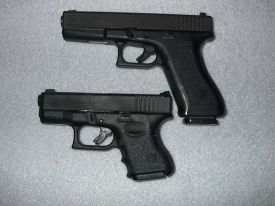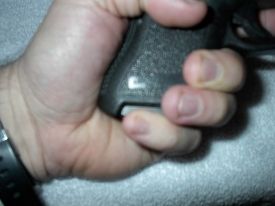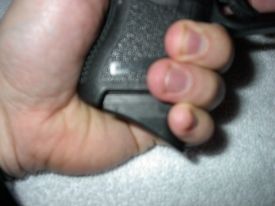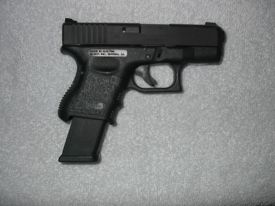
*GLOCK PISTOLS*
Pt. 1 an overview

In 1986, Gaston Glock, an Austrian inventor who specialized in polymers (a high-tech form of plastic), released his model 17 9mm semi-automatic handgun on the US market. This act would revolutionize handgun design. However, to get to the highly respected point the Glock pistols hold in the world handgun market was no easy task.
When the first Glock pistols were released, they were plagued by rumors including that they could pass undetected through airport metal detectors, and that they were unsafe. Both of these rumors were totally untrue.
While the bulk of the receiver on Glock handguns is made of polymer (earning them the nickname "Combat Tupperware"), the slide is totally composed of steel. Thus, there is no way it can sneak through metal detectors.
As for the rumors of a lack of safety, they were based on the fact that Glock handguns were one of, if not the first, semi-automatic handguns designed with no external safety lever. However, there are more safeties on a Glock handgun than there are on any revolver. The Glock handguns all have three safety mechanisms: 1) the trigger safety, 2) the firing pin safety, and c) the drop safety. The only way a Glock handgun will fire is for the trigger to be pulled fully to the rear. The Glock is neither a technically true Single Action, nor a Double Action. Glock calls its action the "Safe Action", which is close to a Double Action. The rumors of a lack of safety also stem from the integration of polymer into the receivers. Up until the Glocks were introduced, Americans were used to all-metal handguns (maybe some wood or plastic grips, but the rest was metal). To integrate something like plastic into a handgun was tantamount to allowing Fisher Price to build your weaponry! However, the polymer used in Glocks is actually stronger and more durable than steel, does not rust, and is far lighter.
The metal parts of Glocks are coated with Tennifer, which is a diamond hard coating that seals out moisture and corrosion. This is not the black matte finish, which is applied over the Tennifer.
There are several models of Glock pistol in production, in many different calibers. These are:
With the exception of the slim-line .45, all Glocks of the same caliber are able to use the magazines of the larger models of the same calibers. For example, the Glock 27 will accept the magazines from the Glock 23 and the Glock 22. This is a great plus when selecting a duty/back-up combination in handguns, which helps explain why 65% of all US police departments use some model of Glock as their issue sidearm.
Glocks are also amazingly reliable. I have owned 3 Glocks, and have put close to 40,000 rounds through them, with not a single non-ammunition related malfunction. Couple that with great out-of-the-box accuracy and the safety and ruggedness of these pistols, and you will be hard pressed to find a better sidearm, out of the box. In most places, Glocks are available for $500.00, or less.
The two main complaints I have heard about Glocks are about the triggers, and the unforgivingness of Glocks towards "limp-wristing". I have never had a problem with the triggers, but those that I have known that have had such problems, have gotten over them with practice. The same holds for the "limp-wristing". This problem occurs if you fail to keep your wrists locked, causing the pistol not to eject correctly.
I have also heard some people complain about shortness of the grip on the sub-compact models, however, there are magazine extenders available to counter act this.
A Glock 22 above a Glock 27…notice the shortness of the grip on the 27

A closer picture of the short grip of a 27, without grip extenders

The Glock 27 with grip extender (attached to bottom of magazine)

The Glock 27 with a Glock 22 magazine inserted.

One drawback to factory Glocks is the stock sights. These are made out of plastic and are not very durable. I would highly suggest getting some night sights installed on any Glock you buy. I have Trijicons on my Glock 22, and Meprolights on my Glock 27.
Glock is currently on its third Generation of its handguns. The first Generation was very similar to the second generation of Glocks (the Glock 22, above is a Generation II) with the texturing on the grips being the major change. Generation III Glocks have the addition of finger grooves (shown on the Glock 27 above) and a slide rail on all compact and full-size Glocks. These rails are similar to those found on the H&K USP pistols, and allow the rapid addition and removal of certain flashlights and lasers.
Part two of this series will cover field stripping and maintenance of Glock Pistols, with the third and final part being dedicated to detail stripping and reassembly.

All materials at this site not otherwise credited are Copyright © 1996 - 2001 Trip Williams. All rights reserved. May be reproduced for personal use only. Use of any material contained herein is subject to stated terms or written permission.